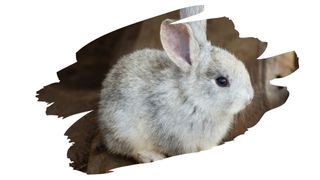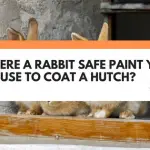Chipboard is a budget-saving substitute for natural timber. Which is why this manufactured wood’s often used to build flat-pack desks and cabinets.
However, as an engineered material, chipboard is far from natural and chemical-free. Instead, this manufactured wood can contain some rather dangerous substances.
So, in this post, we cover what really goes into the manufacture of chipboard. We also reveal why even thoroughly sealed chipboard isn’t safe to have around your pet rabbit.
And keep reading to discover why natural kiln dried wood is the only wood you should use in a rabbit’s hutch.

This post may contain affiliate links to products that we receive a commission for (at no additional cost to you). Learn more here.
What’s Chipboard Really Made Of?
Chipboard (also sometimes referred to as Particle Board or Low Density Fiberboard) is an engineered material. That means that while it may comprise natural wood, (such as sawdust and wood chips), it also contains a lot of glue.
And like other engineered woods, such as OSB and Plywood, chipboard is as far from natural wood as you can get.
Related Post: Is Plywood Safe Enough To Use For A Rabbits Hutch?
Does That Mean Chipboard’s Dangerous To Work With?
Only if it’s not sealed —- or the glues inside of it are still drying out.
You see, the glue used to make chipboard can contain some harsh substances, specifically formaldehyde.
It’s not uncommon to find formaldehyde-resins inside chipboard, since the glue used to make it can contain substances such as urea-formaldehyde, or melamine-formaldehyde.
And it is the formaldehyde-resin found inside its glue that makes newly constructed chipboard dangerous to be near.
Formaldehyde is a deadly substance. It’s poisonous if ingested, and will burn you if it gets on your skin. However, formaldehyde is at its most lethal — both to ourselves and to our pets — if we inhale its vapor.
That Sounds Really Dangerous! Why Risk Using Chipboard At All?
Well, chipboard is only really harmful if the glue inside of it is still off-gassing. Off-gassing refers to the fumes that get released off of drying solvents and glues.
Now, freshly manufactured chipboard can have some pretty poisonous fumes wafting off of it. Especially when formaldehyde-based glues can continue to off-gas for months — and up to two years — after manufacture.
However, once the glue has stopped off-gassing, and you’ve properly coated chipboard with a good wood sealant, it’s safe to have in your home.
Also, responsible chipboard manufacturers will always give this engineered material time to dry out before they ship it. So chipboard will have long since stopped off-gassing, well before we as customers purchase it.
But, chipboard still contains solidified chemical glue. Which means it’s still not safe to have around if there’s a chance it may become ingested.
Wait A Second… Do I Need To Be Worried About Having Chipboard Near My Rabbit?
If there is a greater-than-zero chance of your rabbit chewing into chipboard, then the answer is yes.
Rabbits teeth are sharp enough that they can easily chew through any wood sealant coating chipboard. So, it is best to err on the side of caution and avoid using chipboard inside your rabbit’s hutch.
OK. So What Kind Of Wood Is Safe For Rabbits?
Ideally, you should only use natural untreated kiln-dried wood. And avoid all and any type of chemically-treated timber.
So this means all manufactured woods — from Plywood to MDF to Chipboard — should get crossed off your list.
Related Post: Is MDF Safe Enough For A Rabbits Hutch?
Also, make sure that the specific wood you’re using comes from a rabbit-safe tree species. For example, the timber from select fruit-bearing trees, such as Apple trees, is safe for chew-happy rabbits.
Further more, (and this often gets overlooked), avoid sap-saturated timber.
The trunks of fir and pine trees contain considerable amounts of tree sap. And whilst tree sap is a natural resin, it is not prudent to let your rabbit chew (and possibly ingest) large amounts of it.
The only time you may use sap-rich timbers is if that wood is kiln-dried. Kiln-drying wood will evaporate away most (if not all) excess tree sap.
Still, you’re much better off staying cautious and steering clear of these wood types, anyway.
What Do you Mean By Kiln Dried?
Kiln drying is a quick way to season wood by using heat.
This involves baking freshly logged wood (also referred to as ‘green wood’) inside a kiln oven for a few days.
Related Post: Can You Paint Green Wood? (Solved!)
This method of seasoning drastically reduces the time it takes to season wood — right down to a matter of days.
Better yet, kiln drying not only seasons wood more quickly, it also gets rid of excess sap, bugs, and insects too.
Related Post: Is Kiln Dried Wood Safe Enough For Rabbits To Chew?
To Wrap Up, Here Are The 3 Key Takeaways From This Post…
- 1). Chipboard is an engineered wood. While it may contain natural wood chips, it also contains significant amounts of chemical glue.
- 2). If there’s a chance your rabbit could chew into chipboard, do not use it inside a rabbit’s hutch.
- 3). Only place wholly natural untreated kiln-dried wood in your rabbits home. And avoid using any chemically treated wood.
References:
Enhancing your rabbit’s diet | RSPCA.org.uk
Pędzik M, Auriga R, Kristak L, Antov P, Rogoziński T. Physical and Mechanical Properties of Particleboard Produced with Addition of Walnut (Juglans regia L.) Wood Residues. Materials (Basel). 2022 Feb 9;15(4):1280. doi: 10.3390/ma15041280. PMID: 35207821; PMCID: PMC8880566.



